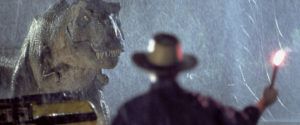
The Definitives
Critical essays, histories, and appreciations of great films
Jurassic Park
- Director
- Steven Spielberg
- Cast
- Sam Neill, Laura Dern, Jeff Goldblum, Richard Attenborough, Bob Peck, Samuel L. Jackson, Wayne Knight, Joseph Mazzello
- Rated
- PG-13
- Runtime
- 127 min.
- Release Date
- 06/11/1993
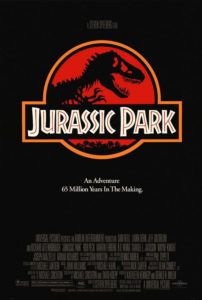
Steven Spielberg’s Jurassic Park uses marvelous visuals to suspend its audience and characters in awe and revelation. Early in the film, a jeep of skeptical scientists and experts in their field drive onto the rolling hills of impresario John Hammond’s island theme park. A wide shot moves inward toward the spellbound faces of Dr. Alan Grant and Dr. Ian Malcolm, though Spielberg delays cutting to what has drawn their eyes. The director holds the shot, filling his audience with anticipation for whatever might evoke their reaction. As the scene builds, we follow Grant, who removes his hat and stands up to get a better look. His mouth agape, Grant clumsily pulls his glasses off his face to reveal his bewildered eyes. The shot goes to Grant’s colleague and significant other, Dr. Ellie Sattler, who chatters on, mystified by a rare and extinct prehistoric plant she found on the island. Grant reaches back and turns her head to see what he sees, and her jaw drops mid-sentence. She too rises and removes her glasses, standing next to Grant in astonishment. The shot moves behind them, rising along with John Williams’ iconic score to greet a towering Brachiosaurus, a full-grown dinosaur whose long neck reaches to the treetops. The power of this scene resides both in the promise of something grandiose captured in the actors’ expressions and the fulfillment of that promise by way of outstanding movie magic: the convincing realization of a relic from Nature that now stands before our very eyes.
This scene in Jurassic Park marks a Spielbergian signature. Scenes like it have been employed throughout the director’s body of work countless times—where the character-spectator sees something overwhelming before the audience does, thus inviting our fascination, or where the audience sees through the spectator’s point of view. The tactic was used when Chief Brody first eyes the shark in Jaws (1975), when Roy and Jillian in Close Encounters of the Third Kind (1977) finally see that Devils Tower is the monolith from their visions, when Elliot first sees the alien in E.T.: The Extra-Terrestrial (1981), or when the alien tripods erupt from under the city in War of the Worlds (2005) as Tom Cruise’s character can do nothing but watch. Elsewhere, Spielberg brings to life horrors that we could only imagine and perhaps never wanted to see, and yet we need to see because of their historical significance, so much so that we cannot look away, such as gas chambers in Schindler’s List (1993) or the D-Day invasion of Normandy beach in Saving Private Ryan (1998). In each case, Spielberg’s method creates a powerful desire to see whatever has ensnared his characters, and then he delivers an often breathtaking spectacle to satisfy that desire. Spielberg is the pusher of our visual gaze. Not only does he implant the longing, if not desperate need to look upon something great, but he makes the act of looking a believable and, without exception, stunning experience. What could be more cinematic?
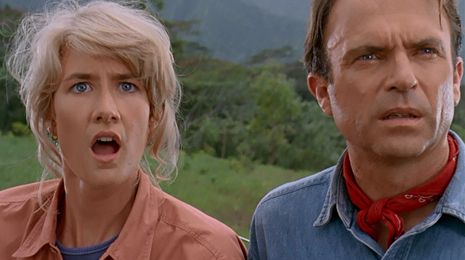 When Jurassic Park opened in the summer of 1993, Spielberg realized the childhood dreams of countless moviegoers by bringing dinosaurs back to life. What he achieved in his adaptation of Michael Crichton’s novel was an unparalleled realization of a natural presence whose only earthly reality could be seen in museum fossils. Films had tried for decades to deliver convincing dinosaurs to the screen. From The Lost World (1925) to The Beast from 20,000 Fathoms (1953), from Godzilla (1954) to The Land that Time Forgot (1975), B-movie dinosaurs were achieved by men in foam suits and stop-motion animation. Though they evoked amazement in generations of older audiences, and still contain an undeniable sense of adventure and escape today, they could not live up to increasing demands for cinematic realism, or the ever-diminishing suspension of disbelief in modern viewers. Spielberg himself said he was always more fascinated by the giant lizards in King Kong (1932) than the titular ape, and so the director had his own expectations to meet. He embarked on a risky and uncertain venture to bring dinosaurs to life, using not only Crichton’s well-researched scientific ideas to reinforce the plausibility of the plot, but new and untested cinematic technologies that could engineer the dreams of millions of moviegoers.
When Jurassic Park opened in the summer of 1993, Spielberg realized the childhood dreams of countless moviegoers by bringing dinosaurs back to life. What he achieved in his adaptation of Michael Crichton’s novel was an unparalleled realization of a natural presence whose only earthly reality could be seen in museum fossils. Films had tried for decades to deliver convincing dinosaurs to the screen. From The Lost World (1925) to The Beast from 20,000 Fathoms (1953), from Godzilla (1954) to The Land that Time Forgot (1975), B-movie dinosaurs were achieved by men in foam suits and stop-motion animation. Though they evoked amazement in generations of older audiences, and still contain an undeniable sense of adventure and escape today, they could not live up to increasing demands for cinematic realism, or the ever-diminishing suspension of disbelief in modern viewers. Spielberg himself said he was always more fascinated by the giant lizards in King Kong (1932) than the titular ape, and so the director had his own expectations to meet. He embarked on a risky and uncertain venture to bring dinosaurs to life, using not only Crichton’s well-researched scientific ideas to reinforce the plausibility of the plot, but new and untested cinematic technologies that could engineer the dreams of millions of moviegoers.
In its broad strokes, Jurassic Park is very much a monster movie, what Spielberg called “a helluva yarn”. Recklessly enthusiastic entrepreneur John Hammond (Richard Attenborough) prepares to debut an island theme park, featuring prehistoric creatures that will “drive kids out of their minds”. His scientists have bred dinosaurs using DNA from ancient mosquitos preserved in amber, but, of course, the resulting animals have proved dangerous. Nervous investors demand Hammond receive endorsements, and so Hammond calls upon three specialists—intellectual paleontologist Alan Grant (Sam Neill), earthy paleobotanist Ellie Sattler (Laura Dern), and unconventional Chaos Theory mathematician Ian Malcolm (Jeff Goldblum)—to experience the titular park and ensure his funding continues. Hammond flies the specialists to his private island off Costa Rica, and also invites his grandchildren, his “target audience” of Lex (Ariana Richards) and Tim (Joseph Mazzello). As the scientists and grandkids tour the park, the kids represent a challenge for the child-resistant Grant, whose companion Ellie wants children, while Malcolm’s eccentricities test the entire group. Meanwhile, Hammond’s disgruntled programmer Dennis Nedry (Wayne Knight) executes a program that shuts off the park’s electricity, if only so he can escape the island with dinosaur embryos to sell to Hammond’s competitor. Nedry’s plan goes south, and dinosaurs run wild all over the island, throwing man and beast together for the first time in 65 million years.
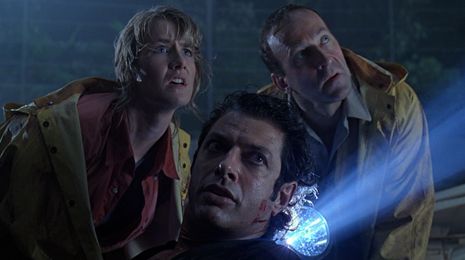 The film’s basic setup and execution play out using a number of formulas, familiar and yet renewed by both Spielberg’s expert direction and realistic, dino-centric scenario. Likewise, the story’s straightforward outline is a common concept for Crichton, already explored in the film Westworld (1973), which Crichton wrote and directed, about a malfunctioning Wild West theme park that wreaks havoc on its visitors. It also bears similarities to Crichton’s 1980 book Congo, where an expedition goes searching for treasure in an exotic jungle location and finds themselves victim to ancient, smarter-than-average animals. Like that story, and many other Crichton texts, Jurassic Park also contains elements of a spy yarn, specifically corporate espionage, through the Nedry subplot. But those are more Crichton’s concerns than Spielberg’s. “I was really just trying to make a good sequel to Jaws, on land,” the director said. Indeed, Jurassic Park bears certain similarities to Spielberg’s 1975 shark thriller. Both films concern powerful, frightening, man-eating creatures from Nature; both put children in peril; both feature a protagonist with a special, informed fear of their monster; and both revolve around monsters that, to this day, frighten their director. Spielberg’s proven and enduring ability to identify with children allows him to capture our deep-rooted sense of pure wonder and terror over dinosaurs, and then channel it onto the screen.
The film’s basic setup and execution play out using a number of formulas, familiar and yet renewed by both Spielberg’s expert direction and realistic, dino-centric scenario. Likewise, the story’s straightforward outline is a common concept for Crichton, already explored in the film Westworld (1973), which Crichton wrote and directed, about a malfunctioning Wild West theme park that wreaks havoc on its visitors. It also bears similarities to Crichton’s 1980 book Congo, where an expedition goes searching for treasure in an exotic jungle location and finds themselves victim to ancient, smarter-than-average animals. Like that story, and many other Crichton texts, Jurassic Park also contains elements of a spy yarn, specifically corporate espionage, through the Nedry subplot. But those are more Crichton’s concerns than Spielberg’s. “I was really just trying to make a good sequel to Jaws, on land,” the director said. Indeed, Jurassic Park bears certain similarities to Spielberg’s 1975 shark thriller. Both films concern powerful, frightening, man-eating creatures from Nature; both put children in peril; both feature a protagonist with a special, informed fear of their monster; and both revolve around monsters that, to this day, frighten their director. Spielberg’s proven and enduring ability to identify with children allows him to capture our deep-rooted sense of pure wonder and terror over dinosaurs, and then channel it onto the screen.
Perhaps this is why seeing dinosaurs in the flesh remains so essential to the Jurassic Park viewing experience. The film is, after all, largely about watching the actors react to what they see. Before nearly every dinosaur’s appearance, Spielberg shows us someone seeing the dinosaur first. We see their reaction, their face light up with amazement or dread, and that expression feeds the viewer’s reaction when the film cuts to the animal. Before the group finds a sickly Triceratops, Grant’s calm inquisitiveness and Tim’s defiant curiosity prepare us not for a shock, but for an intimate encounter where we find a living, breathing, and tangible animal before us, so real that no amount of scrutiny could convince us otherwise. In another sequence, Lex and Tim are left to feast in the visitor’s center after their horrifying jungle adventure. As Lex lifts a spoonful of jello to her mouth, she freezes, and her hand trembles so much that we can hear the jello smacking on the spoon. Then we see what she sees: Behind a painted screen of a Velociraptor, the silhouette of an actual Velociraptor lines up almost perfectly, snorting and sniffing. Tim, who has followed his sister’s stare to the silhouette, gasps in shock. Perhaps the film’s most famous scenes involve hearing the dinosaurs before they appear, as when a glass of water or puddle pulsate from the tremor of the T-rex’s heavy footsteps. Dinosaurs only consume a staggeringly short 15 minutes of screentime, yet they have been burned into the collective moviegoer memory because the actors convince us that the dinosaurs are real. Had their performances and our belief in their fear of these beasts not been so convincing, our belief in the dinosaurs themselves would have been lesser so, and the film not as effective.
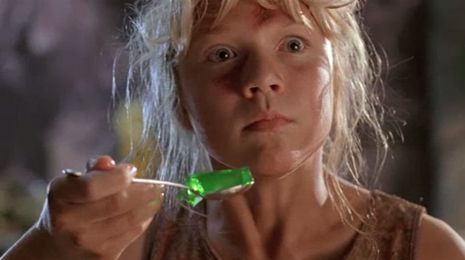 Long before Crichton’s novel was published in 1990, Spielberg, fascinated by such prehistoric animals, had his eye on the author’s dinosaur book; but then, so did half of Hollywood. Several studios began a bidding war over the unpublished property. 20th Century Fox had Gremlins (1984) helmer Joe Dante lined up, Columbia Pictures felt Richard Donner of Lethal Weapon (1987) fame should direct, and Warner Bros. wanted their Batman (1989) cash cow Tim Burton behind the camera. But Universal Studios had an advantage, as Crichton and Spielberg had already started collaborating on a medical television series that would eventually become ER (1994-2009). Universal won the bid, paying Crichton $1.5 million for the film rights to his novel, as well as an additional $500,000 to adapt his book into screenplay form. Meanwhile, Spielberg wrapped production on Hook (1991) and hoped to film Schindler’s List afterward; however, Universal refused to greenlight Spielberg’s Holocaust drama unless the director made Jurassic Park first. The deal was struck. After Hook‘s screenwriter Malia Scotch Marmo gave Crichton’s draft an unfavorable rewrite, Spielberg hired David Koepp, then the little-known screenwriter of Bad Influence (1990). Koepp injected the material with his standard fast-paced plotting and cleverly nuanced character descriptions, which would later become his signature in Mission: Impossible (1996) and War of the Worlds. The writer also simplified complex exposition (and followed Spielberg’s idea to explain dino-DNA with a cartoon), changed characterizations (Hammond becomes a loveable showman, instead of how Crichton wrote him, as a cruel businessman), and removed scenes for pacing and budgetary reasons (many of which ended up in the sequels). In all, without Koepp, the finished film would have been a much different experience.
Long before Crichton’s novel was published in 1990, Spielberg, fascinated by such prehistoric animals, had his eye on the author’s dinosaur book; but then, so did half of Hollywood. Several studios began a bidding war over the unpublished property. 20th Century Fox had Gremlins (1984) helmer Joe Dante lined up, Columbia Pictures felt Richard Donner of Lethal Weapon (1987) fame should direct, and Warner Bros. wanted their Batman (1989) cash cow Tim Burton behind the camera. But Universal Studios had an advantage, as Crichton and Spielberg had already started collaborating on a medical television series that would eventually become ER (1994-2009). Universal won the bid, paying Crichton $1.5 million for the film rights to his novel, as well as an additional $500,000 to adapt his book into screenplay form. Meanwhile, Spielberg wrapped production on Hook (1991) and hoped to film Schindler’s List afterward; however, Universal refused to greenlight Spielberg’s Holocaust drama unless the director made Jurassic Park first. The deal was struck. After Hook‘s screenwriter Malia Scotch Marmo gave Crichton’s draft an unfavorable rewrite, Spielberg hired David Koepp, then the little-known screenwriter of Bad Influence (1990). Koepp injected the material with his standard fast-paced plotting and cleverly nuanced character descriptions, which would later become his signature in Mission: Impossible (1996) and War of the Worlds. The writer also simplified complex exposition (and followed Spielberg’s idea to explain dino-DNA with a cartoon), changed characterizations (Hammond becomes a loveable showman, instead of how Crichton wrote him, as a cruel businessman), and removed scenes for pacing and budgetary reasons (many of which ended up in the sequels). In all, without Koepp, the finished film would have been a much different experience.
Bringing the dinosaurs to life was Spielberg’s greatest challenge in Jurassic Park. If the dinosaurs were unconvincing, his entire film wouldn’t have worked. “I just opened the toolbox and took out every tool there was,” said Spielberg of his approach. To create the film’s dinosaurs, he consulted every kind of special FX artist he could find. First he talked to Bob Gurr, designer of the Universal Studios theme park “King Kong Encounter” ride, but instead chose Stan Winston’s special FX company, then famous for designs in James Cameron’s The Terminator (1984) and John McTiernan’s Predator (1987). Winston and his team would create the life-size, tactile animatronics for the Tyrannosaurus rex, Velociraptors, Dilophosaurus, and sick Triceratops, all using lifelike skins and molds. Though Spielberg consulted stop-motion maestro Phil Tippett to create go-motion dinosaurs for scenes requiring faster movement, the result left the director unconvinced. He wanted his audience to believe the dinosaurs were real. Dennis Muren of Industrial Light & Magic suggested computer-generated imagery (CGI), which until this point had not been successfully executed to look photo-real. Spielberg and Tippett watched ILM’s first animated demonstration of the scene in which the T-rex chases a flock of Gallimimus, and both were amazed. “You’re out of a job,” Spielberg said to Tippet. “Don’t you mean extinct?” replied Tippet. The moment even made its way into the film, when Malcolm says the same thing to Grant about the futility of paleontology in the face of living specimens.
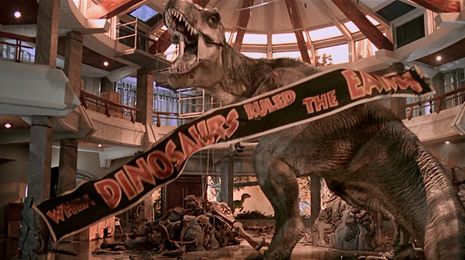 It’s ironic that the first foray into CGI characters remains one of the most convincing, despite decades passing since Jurassic Park‘s release, during which animators have had ample opportunity to improve CGI technology. And yet—along with soundman Gary Rydstrom’s Oscar-winning designs for the dinosaurs’ voices, using an unimaginable array of animal sounds—the film’s dinosaurs never fail to convince us of their reality. Every curve of their skin, every shadow, and every reflection is accounted for, requiring little suspension of disbelief. In fact, Jurassic Park received some mild disapprovals because many critics felt the dinosaurs outshined the humans. How could they not? Human beings have dreamed of seeing dinosaurs in the flesh for centuries, and Spielberg’s team went to great lengths to reinvent the cinematic dinosaur to coincide with modern theories; specifically, their relationship and probable evolution to avian species, or correcting the T-rex’s upright pose to one parallel with the ground. But upon repeated viewings, the subtleties of the human performances become just as interesting as the dinosaurs. And while few become as three-dimensional as Chief Brody in Jaws, they remain engaging with each revisitation. Goldblum’s turn as the talky, overconfident Ian Malcolm echoes his performance in The Fly (1986), and thoroughly engages the viewer in his point of view—that what Hammond has done represents “the rape of the natural world”. The quietly warm scenes between Grant (another reluctant Spielberg father-figure) and Hammond’s grandchildren, or the perceivable unspoken bond between Grant and Sattler, endear us to their relationship. Smaller characters are cleverly defined through dialogue: Wayne Knight’s deplorable Dennis Nedry (“Don’t get cheap on me Dodgson”), Samuel L. Jackson’s engineer Arnold (“Hold onto your butts”), and the late Bob Peck’s park game warden Robert Muldoon (“Clever girl”).
It’s ironic that the first foray into CGI characters remains one of the most convincing, despite decades passing since Jurassic Park‘s release, during which animators have had ample opportunity to improve CGI technology. And yet—along with soundman Gary Rydstrom’s Oscar-winning designs for the dinosaurs’ voices, using an unimaginable array of animal sounds—the film’s dinosaurs never fail to convince us of their reality. Every curve of their skin, every shadow, and every reflection is accounted for, requiring little suspension of disbelief. In fact, Jurassic Park received some mild disapprovals because many critics felt the dinosaurs outshined the humans. How could they not? Human beings have dreamed of seeing dinosaurs in the flesh for centuries, and Spielberg’s team went to great lengths to reinvent the cinematic dinosaur to coincide with modern theories; specifically, their relationship and probable evolution to avian species, or correcting the T-rex’s upright pose to one parallel with the ground. But upon repeated viewings, the subtleties of the human performances become just as interesting as the dinosaurs. And while few become as three-dimensional as Chief Brody in Jaws, they remain engaging with each revisitation. Goldblum’s turn as the talky, overconfident Ian Malcolm echoes his performance in The Fly (1986), and thoroughly engages the viewer in his point of view—that what Hammond has done represents “the rape of the natural world”. The quietly warm scenes between Grant (another reluctant Spielberg father-figure) and Hammond’s grandchildren, or the perceivable unspoken bond between Grant and Sattler, endear us to their relationship. Smaller characters are cleverly defined through dialogue: Wayne Knight’s deplorable Dennis Nedry (“Don’t get cheap on me Dodgson”), Samuel L. Jackson’s engineer Arnold (“Hold onto your butts”), and the late Bob Peck’s park game warden Robert Muldoon (“Clever girl”).
For better or worse, Jurassic Park helped launch a new wave and style of digital filmmaking, where movie sets consist of vast blue rooms and performers interact with a visual cue that will be filled in by CGI during post-production. The actors of Jurassic Park were pioneers in this respect; their responsiveness to animals that are not there never fails to convince us of their fear or wonderment—watching Dern scream in terror as a T-rex approaches behind their speeding Jeep is enough to convince us of that. Audiences the world over believed in dinosaurs too when Spielberg’s film opened in June of 1993. Jurassic Park outperformed Spielberg’s E.T. the Extra-Terrestrial to become the highest grossing film ever made at the time, earning $357 million in the U.S., a record held until James Cameron’s Titanic opened in 1997. Other filmmakers such as George Lucas and Peter Jackson took the hint that integrating live-action with digital animation was the future of special FX, leading Lucas to pursue his Star Wars prequels and Jackson to develop The Lord of the Rings and King Kong. Entire setpieces could be created on computers, and Hollywood saw the cost benefits of building cinematic worlds this way, often with mixed results. Jurassic Park‘s legacy resulted in an underwhelming insurgence of CGI creations, many of which cannot compare to Spielberg’s original theme park world, including the film’s sequels. Moviegoers were reminded of the original’s power in a 2013 re-release in 3D, one of the best ever uses of the gimmicky format, which made the film’s dinosaurs even more compelling.
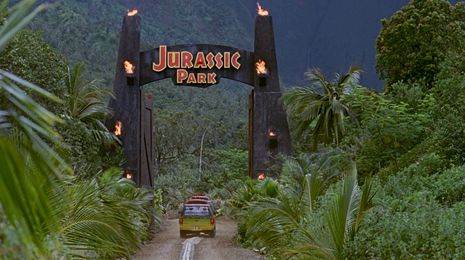 With Jurassic Park, Spielberg shows us the impossible and does it with all the exhilaration of a theme park ride. The film operates like the initial grand climb on a rollercoaster, ascending toward that first moment when the Brachiosaurus looms overhead, gentle and graceful, and stands on its hind legs to reach a branch of leaves. The rollercoaster tips into a thrilling fall when the Tyrannosaurus rex chomps through its fence and investigates the tour group, like a bird pecking at its prey, and our hearts flutter. The ride rails around unexpected corners when the Velociraptors hunt Hammond’s grandchildren and, to our horror, open doors and virtually speak to one another in shrill caws. Spielberg taps into our excitement by building upon it through his actors’ anticipant and fearsome faces, but also by channeling our lifelong fascination with these ancient animals, which by Nature can now only exist in our mind’s eye as we imagine their place in reality through fossils in museums. Indeed, more than his killer shark or various encounters with space aliens, Spielberg realizes an incredible force of Nature, and in Jurassic Park finds a place where imagination and possibility merge. He achieves one of the great possibilities of cinema by bringing us something we have always dreamed of seeing, and he makes us believe each visual spectacle he has conjured before our eyes. Truly, Spielberg is one of the great cinematic magicians, a virtuoso whose masterful manipulation of his audience and unparalleled execution imbues this film with an enduring timelessness.
With Jurassic Park, Spielberg shows us the impossible and does it with all the exhilaration of a theme park ride. The film operates like the initial grand climb on a rollercoaster, ascending toward that first moment when the Brachiosaurus looms overhead, gentle and graceful, and stands on its hind legs to reach a branch of leaves. The rollercoaster tips into a thrilling fall when the Tyrannosaurus rex chomps through its fence and investigates the tour group, like a bird pecking at its prey, and our hearts flutter. The ride rails around unexpected corners when the Velociraptors hunt Hammond’s grandchildren and, to our horror, open doors and virtually speak to one another in shrill caws. Spielberg taps into our excitement by building upon it through his actors’ anticipant and fearsome faces, but also by channeling our lifelong fascination with these ancient animals, which by Nature can now only exist in our mind’s eye as we imagine their place in reality through fossils in museums. Indeed, more than his killer shark or various encounters with space aliens, Spielberg realizes an incredible force of Nature, and in Jurassic Park finds a place where imagination and possibility merge. He achieves one of the great possibilities of cinema by bringing us something we have always dreamed of seeing, and he makes us believe each visual spectacle he has conjured before our eyes. Truly, Spielberg is one of the great cinematic magicians, a virtuoso whose masterful manipulation of his audience and unparalleled execution imbues this film with an enduring timelessness.
Bibliography:
Friedman, Lester D. Citizen Spielberg. Champaign: University of Illinois Press, 2006.
McBride, Joseph. Steven Spielberg (Third Edition). London. Faber and Faber, 2012.






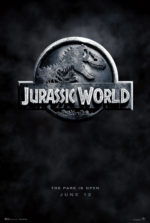 Jurassic World
Jurassic World 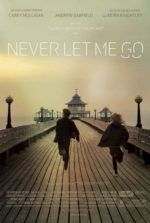 Never Let Me Go
Never Let Me Go 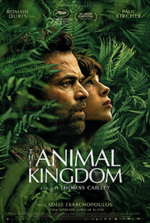 The Animal Kingdom
The Animal Kingdom